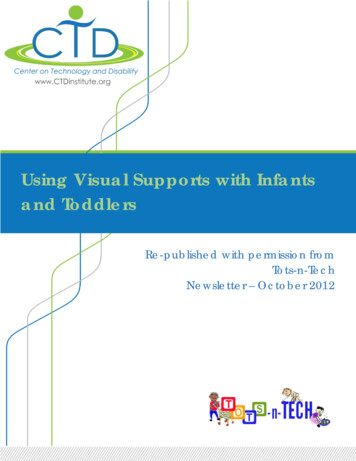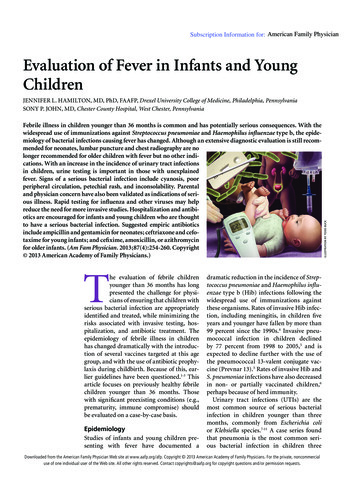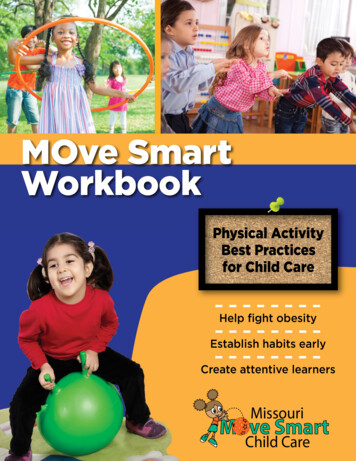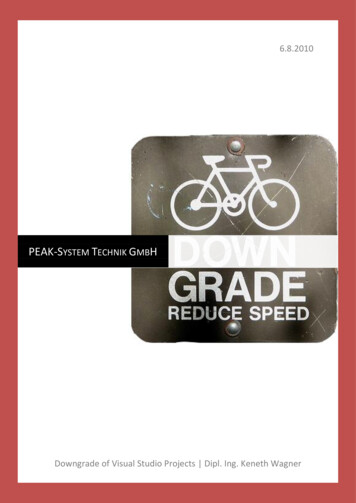
Transcription
Using Visual Supports with Infantsand ToddlersRe-published with permission fromTots-n-TechNewsletter – October 2012
1Thomas JeffersonUniversityArizona StateUniversityOctober 2012E-NewsletterUS I N GVI S U A LSU P P O R T SW I T HIN FA N T SIn This IssueWhat are visualsupports?1-2Deciding whichtype of visualsupport to use2Types of visualsupports3-8Example:Transitions9Tips for makingvisual supports10Implementationof visual supports10What are Visual Supports?Visual supports are graphic cues that can be used to aid communicationbetween parents and children or as an environmental prompt that helpschildren remember what is expected of them in a certain activity orroutine. Visual supports take many different forms and have various uses.They may be used to:Helpful links11A N DTO D D L E R SVisual supports are a form of adaptation that rely on visual cues to allowinfants and toddlers, and older children, to participate in activities androutines. Because infants and toddlers may find it difficult tocommunicate using words, visual supports can provide them with a systemfor communication while also teaching them important daily activities androutines. Visual supports provide supplemental information, cues, anddirections to children who may communicate with behavior or are unableto read.This newsletter will take visualsupports that have been usedsuccessfully in childcare centers andpreschools and show how they can beused in the home with youngerchildren. As you will see, visualsupports can be inexpensive to makeand are applicable to many differentdaily activities and routines in alldifferent environments!Prevent challenging behavior & support social competenceSupport communicationEnhance memoryProvide a reference for previous directionsIdentify expectations for children within activities and routinesServe as a cue for new skillsArizona State University - Tots-n-Tech E-Newsletter, October 2012 - Thomas Jefferson University
2What are Visual Supports? (Continued)Because visual supports are useful in so many varied capacities, they may be used with bothtypically developing children and children with disabilities. As children become morefamiliar with the roles visual supports play in routines and activities, the supportsthemselves can become a stand-in for parents or providers assisting the child and will helpthe child develop self-monitoring behaviors. Eventually young children will stop using thesevisual supports naturally; parents will not need to worry about children becomingdependent on the support or needing to phase them out of a routine.A visual support can range from something as simple as an eggtimer acting as a signal to a child when their time in one activitywill end, to something that requires more work, such as anindividualized social story to provide a child with reference towhat is happening in their environment. For instance, in the photoon the right a rather simple visual support is used. Teachers in adaycare center found that children were stomping on the lever ofthe trashcan to make the lid rise and fall. If they did not push hardenough the children would use their hands to lift the lid the rest ofthe way. After telling the children that they were getting germs ontheir hands by touching the trashcan, teachers noticed that thechildren continued to touch the lid. After adding drawings of germsto the lid of the trashcan to remind children of what they had beentold before, teachers noticed that children stopped touching thetrashcan lid.Deciding Which Type of Visual Support to UseBefore sitting down to make a visual support for a young child, it is important to considerthe child’s needs for supports. That is, how well does the child participate when comparedto your expectations? Then decide what your goals are for the child. This will help youfocus on the specific things you will need to do to change the situation. Next, consider youroptions. Would a social story be a better solution to help the child deal with transitionsthan a first then board?After selecting which visual support seems right, the next step is to determine what visualcues will be most useful. For most infants and toddlers, either objects or real life photoswill be helpful cues. For example, actual objects and items may be used as a means tocommunicate. For example, when preparing for story time, Malachi’s mother holds up twobooks, allowing him to choose which he would like to read. When children are responsive tophotos, real photographs may be used to communicate. In this instance, Annie’s mothershows her a photo of cereal or eggs so that Annie may choose what she would like to eat forbreakfast.Arizona State University - Tots-n-Tech E-Newsletter, October 2012 - Thomas Jefferson University
3Types of Visual SupportSocial StoriesSocial stories give children a personalizedreference that provides comfort and assists inmemory development and self-regulation. Thesepersonalized books tell a story of a specificoccurrence and help the child understand whatis expected of them in that situation withoutproviding a definite script. In addition toproviding expectations, social stories mayhighlight others’ emotions or opinions, providebehavioral choices to the child, and highlightcommonly shared values within the culture.Social stories should reassure the child andprovide information about challenging activities.After being used enough, social stories may start to act as scripts to help children organizeand interpret daily events. It is important that the stories are worded in a way thatemphasizes what is expected — what should happen — rather than what is actuallyoccurring. Social stories may be made for any situation. Jackson’s mother made him abook to help him learn how to use the potty.Example: Jackson has trouble remembering to use the potty when he needs it. To helpteach him the steps to using the potty, Jackson’s home-based teacher created a social storythat describes the situation (I am learning how to use the potty!), refers to his mother’sfeelings when he uses the potty (Mommy feels proud when I use the potty all by myself),provides him with different ways to behave (I flush the potty when I am done. Then I washmy hands with soap and water), and highlights a commonly shared value (I feel so happyafter going potty all by myself!). Jackson’s mother read the social story to him each timeshe dressed him in his big boy underwear. Over time Jackson began telling his mother whenhe needed to use the potty and learned how to do it all by himself!MAKE IT!When writing the story, use descriptive statements to give details that may be appliedto the child’s environment. Take photos of the child participating in the activity to useas a backdrop for your social story and put them beside each statement. Be sure tohave faces for each emotion you detail in the story so that the child can identify withothers. To make a storybook put each statement and accompanying picture on its ownpage. Then punch a hole in the top left corner and tie together with ribbon or binderring. Keep the social story book in a convenient place (in the above example, it couldbe the bathroom or bedroom).Arizona State University - Tots-n-Tech E-Newsletter, October 2012 - Thomas Jefferson University
4Types of Visual Support (Continued)Visual SchedulesVisual schedules lay out the events of a day or routineone by one for children. They give children a clearsense of the sequence and expectations of the day.Visual schedules may take many forms: specific orgeneral, listing the events horizontally or vertically,removing events as they are complete or moving anarrow to identify the event presently occurring. In thephoto on the left, each page in a binder represents adifferent routine. For the morning routine, first thechild wakes up, then brushes teeth, then brushes hair,etc. As activities and routines are completed on thevisual schedule, the pictures may be removed and put into a small envelope or otherstorage container so that the child knows those activities are completed. Remainingpictures show what is coming rather than what has already happened.Example: Toya had trouble keeping on task and was fussy when transitioning betweenactivities and routines. To teach Toya the order of the day’s events, her father created avisual schedule to hang in her playroom. The schedule began with her morning routine andfollowed all the way through to her bedtime routine. Toya and her father went over thevisual schedule every day so that she could learn to anticipate the activities that werecoming and understand the expectations that came with them. Over time Toya’schallenging behavior stopped and her father found it much easier to help her withtransitions throughout the day.When one part of an activity or a routine is challenging for a child, for instance toothbrushing, the visual schedule may be further broken down to detail that specific part. IfToya is having trouble remembering how to brush her teeth, her father might place adetailed visual schedule for tooth brushing next to the bathroom sink for Toya to consultduring her bedtime routine.MAKE IT!First, determine how specific of a visual schedule is needed. Multiple schedule boardsmay be made when the child needs things to be very specific. Then, you’ll be able tobring out a different board for each segment of the day (ex. morning, afternoon, night).Decide if you’d like your schedule to be vertical or horizontally oriented, then addVelcro to the board. Put a photo and description of each activity onto a card. Make sureall the cards are the same size so they can be moved if there are any changes to yourschedule! Create a pocket at the bottom of the board for the cards if you would like toremove them as they are completed. Put the schedule at your child’s eye level andteach them how to consult and use it.Arizona State University - Tots-n-Tech E-Newsletter, October 2012 - Thomas Jefferson University
5Types of Visual Support (Continued)First Then BoardsFirst then boards are similar to visual schedules inthat they also list a sequence of events. A bigdifference between the two, though, is that firstthen boards teach children that in order to get areward they sometimes need to do a less favorableactivity first. As can be seen in the photo on theright, the board shows a picture of an unfavorabletask on the “first” side and shows a picture of afavorable task on the “then” side. It is important tokeep the words for each activity simple. Theactivity on the “then” side should always bereinforcing to the child. In this instance the board Photo credit: http://ips4specialkids.com/2011/would be read to the child as “First magnetic08/10/first-work-then-play/numbers, then ball bounce.” For infants andtoddlers it is recommended that first then boards contain only 2 activities although theycan contain more than one activity on the “first” side for older children. Children can alsobe involved in the process of choosing their reinforcing activity by presenting them withoptions for what they would like to do (choice boards—page 7).Example: Jerome threw a tantrum every time his grandmother tried to put him down for anap. His grandmother created a first then board to help Jerome understand that after hisnap, something he enjoyed would follow. She made multiple cards with photos and namesof rewarding activities and used them interchangeably on the “then” side of the board toremind Jerome that after the activity that he found unpleasant, a rewarding activity, suchas playing outside or reading a book, would immediately follow. He learned to make theconnection and his tantrums during naptime were significantly lessened.MAKE IT!Draw a thick, dark line dividing a board into two sides. Label the left side of the board“First” and the right side “Then.” Place Velcro on each side of the line for the activitycards to stick to. Take photos of different reinforcing activities and challengingactivities and place them on separate cards. Be sure to label each activity on itscorresponding card so that your child learns the names of the activities. If your childhas trouble following the first then board try using different activities on the “then”side. It is possible that your child may find some activities more reinforcing than others!Arizona State University - Tots-n-Tech E-Newsletter, October 2012 - Thomas Jefferson University
6Types of Visual Support (Continued)Contingency MapsContingency maps depict the antecedentbehavior-consequence (ABC) relationship forchildren’s behavior. They are particularly helpfulwhen children have shown challenging behaviorin certain activities or routines. Contingencymaps teach children what will happen when heor she engages in that challenging behavior.However, they also show what will happen if thechild does not engage in the negative behavior,but instead engages in a positive but functionallyequivalent behavior. In the picture, thecontingency map is read as “If I take a nap, I getplaytime but if I don’t listen, I will not be ableto play after nap.” The contingency map clearlyoutlines the antecedent, behavior, andconsequences of the child’s actions. Theconsequence of the positive behavior should bereinforcing for the child, much like on first thenboards. The consequence of the negativebehavior should be the absence of the reinforcing behavior that was previously stated.Example: Carlos refused to sleep at naptime. His mother created a contingency map to helphim understand that he would have to listen and nap during naptime in order to playafterwards. She took photos of him sleeping peacefully, throwing a tantrum, playing, andsitting in timeout. Carlos’ mother posted the contingency map next to his bed and reviewedMAKE IT!On a large board place Velcro about halfway down on the left side, then 3 more pieceseach of Velcro across the top and bottom. Draw arrows connecting the left to the upperand lower Velcro sections, plus signs between the first two pieces of Velcro, and equalsigns between the last two pieces of Velcro. Then, make cards detailing what leads upto your child’s challenging behavior, the challenging behavior itself, and theconsequence of that behavior. Also make cards that provide your child with positive,but functionally equivalent, behaviors and the rewards you plan on providing for them.If your child exhibits multiple challenging behaviors make cards for each of them.Arizona State University - Tots-n-Tech E-Newsletter, October 2012 - Thomas Jefferson University
7Types of Visual Support (Continued)Choice BoardsChoice boards provide children with differentoptions of what they would like to do withinactivities and routines. In the photo to the right, achild may choose between playing with Mr. PotatoHead, using blocks, painting, or dancing. To preventchildren from confusing the choice board with avisual schedule it can be helpful to arrange thechoices in a shape rather than a line. Choice boardshelp children focus on appropriate options whilegiving them the opportunity to communicate what Photo credit: ty-board-from-mickey-mouse-clubhouse/they would like to do, either verbally or bypointing, depending on functional level. Infants andtoddlers should be given few options at first to learn the purpose of choice boards andprevent confusion. Simple phrases may be used to prompt the child to make a choice andthe choice board can be used across many settings.Example: David is preverbal and unable to communicate through words which objects hewants to use during playtime and gets frustrated when he is not understood. His fathercreated a choice board to help him communicate which toys he wants to use. He makessure that the choices are always different so that David will not get bored. After learning topoint to the toys he would like to play with and working with his speech therapist, Davidhas started to make sounds while pointing. His choice board has helped with hiscommunication both verbally and physically.MAKE IT!On a large board place multiple pieces of Velcro in any shape (i.e., not in a line). Besure not to give too many options so that your child will not feel overwhelmed. Makecards with photos and labels of different activities that can happen within a routine foryour child. For example, if you are making a choice board for snack time put pictures ofdifferent foods, like an apple or crackers. Attach the cards onto the board in differentplaces each time you use the choice board with your child.The choice board can easily be used as a feelings board, too! Make cards with differentemotions and faces to have your child tell you how he or she feeling. Then have yourchild act out the emotions into a mirror.Arizona State University - Tots-n-Tech E-Newsletter, October 2012 - Thomas Jefferson University
8Types of Visual Support (Continued)Other Types of Visual SupportTimer: You can signal to a child how much time is left in anactivity or routine by using a timer with an easy-to-read face.The timer to the right changes from green to yellow when it isalmost time to switch from one activity to the next. When it istime for a new activity or routine the timer will turn red.Timers may be used in conjunction with first then boards orvisual schedules.Stop Signs: Stop signs are be placed on doors to remind childrennot to run outside or to signal to children that a certain room isoff limits. Smaller versions of stop signs may also be used onobjects or places that may pose a danger to children, such as astove or stairway.Cues for Toys: Providing children with visualcues can give direction on what to do with anobject within an activity or routine. Forinstance, on the right, instead of throwingblocks or using them in an inappropriate way,this picture cues a child about what to buildwith blocks.Cue Cards: Cue cards are an easily transportable visualsupport for use in a variety of settings. They can serveas a visual schedule if read in a particular order or canbe used as choice cards. They can be attached to akeychain, like those pictured, or attached as a necklace,or a zipper pull for easy access.Arizona State University - Tots-n-Tech E-Newsletter, October 2012 - Thomas Jefferson University
9USING VISUAL SUPPORTS DURING TransitionsTransitions from one activity to the next can be difficult for most children. They involvesometimes unpredictable situations to which children react negatively. Social stories canhelp explain to children what everyone involved will be doing in the next activity, visualschedules can help lay out upcoming sequences of events, first then boards can ensure thatchildren know what activity will come immediately after, and timers can alert children as towhen the transition is coming. But what if none of these visual supports work?Suggestion 1: Who What Where When Why HowTo prepare a child for a transition, a board can be created with the 6 classic questions, who,what, where, when, why, and how. The cards used should provide specific answers. In thecase of getting ready to leave home for a community outing: Who is going with me? Dad isgoing with me. What am I doing next? Next we are leaving home. Where am I going? We aregoing to the grocery store. When will I be doing it? We will be going to the grocery store after naptime. Why am I doing it? We are going to the grocery store to buy food. How will Iget there? We will take the bus to the grocery store. The who what where when why howstrategy can also be used on cue cards to remind the child what is happening while on thego.Suggestion 2: Getting myself readyUsing magnets, a photo of the child, and photos ofitems the child needs to move from one activity tothe next, this visual support will help the child mentally and physically prepare before moving on to another activity. The main part of this board is a photoof the child. The smaller items that will be used ascards are things that the child will need to get readyfor the next activity. If the child is getting ready toleave the house the cards should be things like shoes,a jacket (depending on the weather), a backpack, ora hat. First, prompt the child to move the shoes ontothe larger photo. Then, have the child go get his orher own shoes and put them on. Repeat this processfor each item until they have all been gathered by the child. The board makes this an interactive visual support and the child will eventually learn the sequence of getting ready toleave the house without being told!Arizona State University - Tots-n-Tech E-Newsletter, October 2012 - Thomas Jefferson University
10Tips for Making Visual SupportsCover backing boards and cards with contact paper or lamination to increase durabilityand make any possible messes easy to clean up. Visual supports for bathtime can usecards in plastic bags attached to suction cups. Get creative; there is no right or wrong!Use Velcro on boards and cards so that they can be applied to different activities.Magnets can be used on a baking sheet or refrigerator, and snaps can be used to work onyour child’s fine motor skills as well.Extra cards can be stored in empty plastic peanut butter jars or baby wipe containers.Make statements in terms of what you want to see in the behavior, not what you alreadysee.Use bright colors to appeal to children’s senses. Using rhymes will help children committhings to memory.Use felt, crumpled tissue paper, or other materials to create a texture on the cards.Younger children will be drawn to the way different cards feel and may attend to themmore than if they were simply paper. Experiment to find what your child likes!Include words with all pictures so that all adults using the visual support with your childwill use the same words each time.If your child is bilingual you can put both languages on the cards—simply use differentcolor ink for each language.If your child has a favorite cartoon character try to incorporate them into the picturesyou use for your visual supports. This will turn your child’s attention to the visualsupport itself and help to teach the lesson more quickly.If using photos, use pictures of the children themselves doing the activity or routine tomake the lessons more tangible.The Implementation of Visual SupportsWhen first introducing a visual support to your child stand behind him or her so as not todistract from the visual information being presented. Be sure to use only relevant languageand help your child participate in the activity or routine. In the beginning it will be helpfulto prompt your child, but those prompts should be lessened as time goes on so that yourchild comes to rely on the support for information rather than an adult.In order for visual supports to be useful to your child the supports must be used consistentlywithin an activity or routine for at least one week. This will teach children to associate thesupport with that activity or routine and eventually stop relying on the support over time.Additionally, visual supports for an activity or routine should be used across differentsettings so that your child will learn to generalize the lessons being taught. For instance,use a first then board while eating dinner at home, but also use it when eating in arestaurant or at grandma’s house.While using the visual support it is important to monitor your child’s level of independencein the task. This will tell you if you are using the appropriate visual support for your child’sneeds. It will also help you track progress in meeting goals for your child’s developmentand behavior.Arizona State University - Tots-n-Tech E-Newsletter, October 2012 - Thomas Jefferson University
11HE L P F U LLI N K S:http://tnt.asu.edu/tnt-helpdeskThe Tots-n-Tech helpdesk offers suggestions for how to make AT devices, including visualsupports, for a variety of different activities and routines that may be challenging for children. New ideas are constantly being TACSEI provides parents, providers, and teachers with research-based strategies to improve the functioning of children. You can find free presentations, articles, and ideas thatcan be immediately applied.http://csefel.vanderbilt.edu/CSEFEL provides resources for families, teachers, and trainers in early intervention. Although many of their visual support materials are aimed toward children in childcare, theyare easily adaptable to the ports/This website offers a visual supports checklist that gives ideas to consider before creatinga visual support for your child. There are also many links that give more background onvisual supports and tips for making visual supports.http://www.do2learn.com/Provides free materials and tips on how to get started using visual supports with ual-supportsAn overview of visual supports along with step by step instructions on how to make choiceboards, visual schedules, and first then tware/Software with a variety of pictures for the activity cards that can be used with any of thevisual supports discussed in this newsletter.Please feel free to forward this newsletter to any individuals or agencies that may benefit frominformation on assistive technology.Questions? Comments? Want to have the newsletter sent directly to your inbox?Email Livia at livia.fortunato@jefferson.eduArizona State University - Tots-n-Tech E-Newsletter, October 2012 - Thomas Jefferson University
Over time Jackson began telling his mother when he needed to use the potty and learned how to do it all by himself! Types of Visual Support MAKE IT! When writing the story, use descriptive statements to give details that may be applied to the child’s environment. Take photos of the child participating in the activity to useFile Size: 1MBPage Count: 12










